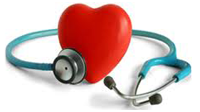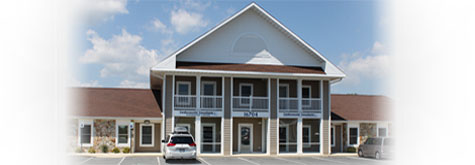Hypertension
WHAT IS IT?
High blood pressure (HBP), or hypertension, is a serious condition that can lead to coronary heart disease, heart failure, stroke, kidney failure, and other health problems. "Blood pressure" is the force of blood pushing against the walls of the arteries as the heart pumps out blood. If this pressure rises and stays high over time, it can damage the body in many ways.
Also Known As: High Blood Pressure
Basic Facts
High blood pressure (HBP) is a serious condition that can lead to coronary heart disease, heart failure, stroke, kidney failure, and other health problems.
"Blood pressure" is the force of blood pushing against the walls of the arteries as the heart pumps out blood. When this pressure rises and stays high over time, it can damage the body in many ways.
Blood pressure numbers include systolic and diastolic pressures. Systolic blood pressure is the pressure when the heart beats while pumping blood. Diastolic blood pressure is the pressure when the heart is at rest between beats.
All blood pressure levels above 120/80 mmHg increase your risk for the health problems related to HBP. A blood pressure level of 140/90 mmHg or higher is considered HBP for most adults. If you have diabetes or chronic kidney disease, a blood pressure of 130/80 mmHg or higher is considered HBP.
Blood pressure tends to rise with age. Certain medical problems and medicines may cause blood pressure to rise. In some women, blood pressure can go up if they use birth control pills, become pregnant, or take hormone replacement therapy.
Children younger than 10 years who have HBP often have another condition that's causing it (such as kidney disease). Treating the underlying condition may resolve HBP.
In the United States, about 72 million people have HBP. This is about 1 in 3 adults. Certain traits, conditions, or habits may raise your risk for HBP. These include older age, race/ethnicity, overweight or obesity, gender, unhealthy lifestyle habits, a family history of HBP, long-lasting stress, and having prehypertension (blood pressure levels between 120-139/80-89).
HBP itself usually has no symptoms. Rarely, headaches may occur. Some people only learn that they have HBP after it causes health problems, such as coronary heart disease, stroke, or kidney failure.
Your doctor will diagnose HBP using the results of a blood pressure test. This test is easy and painless. It may be done several times to make sure the results are correct.
Doctors measure blood pressure in children and teens the same way they do in adults. However, the ranges for normal blood pressure and HBP are different for youth than for adults. These ranges are based on the average blood pressure levels for a child or teen's age, gender, and height.
HBP in adults and children is treated with lifestyle changes and medicines. Lifestyle changes include following a healthy eating plan, doing enough physical activity, maintaining a healthy weight, quitting smoking, and managing and coping with stress.
If you have normal blood pressure, you can take steps to prevent or delay HBP. Healthy lifestyle habits can help you maintain normal blood pressure.
If you have HBP, you can take steps to prevent the long-term problems it can cause. Adopt healthy lifestyle habits and follow the treatment plan your doctor prescribes.
A More Detailed Explanation
About 1 in 3 adults in the United States has HBP. HBP itself usually has no symptoms. You can have it for years without knowing it. During this time, though, it can damage the heart, blood vessels, kidneys, and other parts of your body.
This is why knowing your blood pressure numbers is important, even when you're feeling fine. If your blood pressure is normal, you can work with your health care team to keep it that way. If your blood pressure is too high, you need treatment to prevent damage to your body's organs.
Blood Pressure Numbers
Blood pressure numbers include systolic (sis-TOL-ik) and diastolic (di-a-STOL-ik) pressures. Systolic blood pressure is the pressure when the heart beats while pumping blood. Diastolic blood pressure is the pressure when the heart is at rest between beats.
You will most often see blood pressure numbers written with the systolic number above or before the diastolic, such as 120/80 mmHg. (The mmHg is millimeters of mercury-the units used to measure blood pressure.)
The table below shows normal numbers for adults. It also shows which numbers put you at greater risk for health problems. Blood pressure tends to goes up and down, even in people who have normal blood pressure. If your numbers stay above normal most of the time, you're at risk.
Categories for Blood Pressure Levels in Adults (in mmHg, or millimeters of mercury)
Category
Systolic
(top number)
Diastolic
(bottom number)
Normal
Less than 120
And
Less than 80
Prehypertension
120-139
Or
80-89
High blood pressure
Stage 1
140-159
Or
90-99
Stage 2
160 or higher
Or
100 or higher
The ranges in the table apply to most adults (aged 18 and older) who don't have short-term serious illnesses.
All levels above 120/80 mmHg raise your risk, and the risk grows as blood pressure levels rise. "Prehypertension" means you're likely to end up with HBP, unless you take steps to prevent it.
If you're being treated for HBP and have repeat readings in the normal range, your blood pressure is under control. However, you still have the condition. You should see your doctor and stay on treatment to keep you blood pressure under control.
Your systolic and diastolic numbers may not be in the same blood pressure category. In this case, the more severe category is the one you're in. For example, if your systolic number is 160 and your diastolic number is 80, you have stage 2 HBP. If your systolic number is 120 and your diastolic number is 95, you have stage 1 HBP.
Causes
Blood pressure tends to rise with age, unless you take steps to prevent or control it.
Certain medical problems, such as chronic kidney disease, thyroid disease, and sleep apnea, may cause blood pressure to rise. Certain medicines, such as asthma medicines (for example, corticosteroids) and cold-relief products, also may raise blood pressure.
In some women, blood pressure can go up if they use birth control pills, become pregnant, or take hormone replacement therapy.
Women taking birth control pills usually have a small rise in both systolic and diastolic blood pressures. If you already have high blood pressure (HBP) and want to use birth control pills, make sure your doctor knows about your HBP. Talk to him or her about how often you should have your blood pressure checked and how to control it while taking the pill.
Taking hormones to reduce the symptoms of menopause can cause a small rise in systolic blood pressure. If you already have HBP and want to start using hormones, talk to your doctor about the risks and benefits. If you decide to take hormones, find out how to control your blood pressure and how often you should have it checked.
Risk Factors
In the United States, about 72 million people have high blood pressure (HBP). This is about 1 in 3 adults.
Certain traits, conditions, or habits are known to raise the risk for HBP. These conditions are called risk factors. This section describes the major risk factors for HBP.
Older Age
Blood pressure tends to rise with age. If you're a male older than 45 or a female older than 55, your risk for HBP is higher. Over half of all Americans aged 60 and older have HBP.
Isolated systolic hypertension (ISH) is the most common form of HBP in older adults. ISH occurs when only systolic blood pressure (the top number) is high. About 2 out of 3 people over age 60 who have HBP have ISH.
Race/Ethnicity
HBP can affect anyone. However, it occurs more often in African American adults than in Caucasian or Hispanic American adults. In relation to these groups, African Americans:
- Tend to get HBP earlier in life
- Often have more severe HBP
- Are more likely to be aware that they have HBP and to get treatment
- Are less likely than Caucasians and about as likely as Hispanic Americans to achieve target control levels with HBP treatment
- Have higher rates than Caucasians of premature death from HBP-related complications, such as coronary heart disease, stroke, and kidney failure
HBP risks vary among different groups of Hispanic American adults. For instance, Puerto Rican American adults have higher rates of HBP-related death than all other Hispanic groups and Caucasians. But, Cuban Americans have lower rates than Caucasians.
Overweight or Obesity
You're more likely to develop prehypertension or HBP if you're overweight or obese. Overweight is having extra body weight from muscle, bone, fat, and/or water. Obesity is having a high amount of extra body fat.
Gender
Fewer adult women than men have HBP. But, younger women (aged 18-59) are more likely than men to be aware of and get treatment for HBP.
Women aged 60 and older are as likely as men to be aware of and treated for HBP. However, among treated women aged 60 and older, blood pressure control is lower than it is in men in the same age group.
Unhealthy Lifestyle Habits
A number of lifestyle habits can raise your risk for HBP, including:
- Eating too much sodium (salt)
- Drinking too much alcohol
- Not getting enough potassium in your diet
- Not doing enough physical activity
- Smoking
Other Risk Factors
A family history of HBP raises your risk for the condition. Long-lasting stress also can put you at risk for HBP.
You're also more likely to develop HBP if you have prehypertension. Prehypertension means that your blood pressure is in the 120-139/80-89 mmHg range.
Symptoms and Complications
High blood pressure (HBP) itself usually has no symptoms. Rarely, headaches may occur.
You can have HBP for years without knowing it. During this time, HBP can damage the heart, blood vessels, kidneys, and other parts of the body.
Some people only learn that they have HBP after the damage has caused problems, such as coronary heart disease, stroke, or kidney failure.
Knowing your blood pressure numbers is important, even when you're feeling fine. If your blood pressure is normal, you can work with your health care team to keep it that way. If your numbers are too high, you can take steps to lower them and control your blood pressure. This helps reduce your risk for complications.
Complications of High Blood Pressure
When blood pressure stays high over time, it can damage the body. HBP can cause:
The heart to get larger or weaker, which may lead to heart failure. Heart failure is a condition in which the heart can't pump enough blood throughout the body.
Aneurysms (AN-u-risms) to form in blood vessels. An aneurysm is an abnormal bulge or "ballooning" in the wall of an artery. Common spots for aneurysms are the main artery that carries blood from the heart to the body; the arteries in the brain, legs, and intestines; and the artery leading to the spleen.
Blood vessels in the kidney to narrow. This may cause kidney failure.
Arteries throughout the body to narrow in some places, which limits blood flow (especially to the heart, brain, kidneys, and legs). This can cause a heart attack, stroke, kidney failure, or amputation of part of the leg.
Blood vessels in the eyes to burst or bleed. This may lead to vision changes or blindness.
Diagnosis
Your doctor will diagnose high blood pressure (HBP) using the results of blood pressure tests. These tests will be done several times to make sure the results are correct. If your numbers are high, your doctor may have you return for more tests to check your blood pressure over time.
If your blood pressure is 140/90 mmHg or higher over time, your doctor will likely diagnose you with HBP. If you have diabetes or chronic kidney disease, a blood pressure of 130/80 mmHg or higher is considered HBP.
If you're diagnosed with HBP, you will need treatment. You also will need to have your blood pressure tested again see how treatment affects it.
Once your blood pressure is under control, you will need to stay on treatment. "Under control" means that your blood pressure numbers are normal. You also will need regular blood pressure tests. Your doctor can tell you how often you should be tested.
The sooner you find out about HBP and treat it, the better your chances to avoid problems like heart attack, stroke, and kidney failure.
Tests
A blood pressure test is easy and painless. This test is done at a doctor's office or clinic.
To prepare for the test:
Don't drink coffee or smoke cigarettes for 30 minutes prior to the test. These actions may cause a short-term rise in your blood pressure.
Go to the bathroom before the test. Having a full bladder can change your blood pressure reading.
Sit for 5 minutes before the test. Movement can cause short-term rises in blood pressure.
To measure your blood pressure, your doctor or nurse will use some type of a gauge, a stethoscope (or electronic sensor), and a blood pressure cuff.
Most often, you will sit or lie down with the cuff around your arm as your doctor or nurse checks your blood pressure. If he or she doesn't tell you what your blood pressure numbers are, you should ask.
Treatment
High blood pressure (HBP) is treated with lifestyle changes and medicines.
Most people who have HBP will need lifelong treatment. Sticking to your treatment plan is important. It can prevent or delay the problems linked to HBP and help you live and stay active longer.
Goals of Treatment
The treatment goal for most adults is to get and keep blood pressure below
140/90 mmHg. For adults who have diabetes or chronic kidney disease, the goal is to get and keep blood pressure below 130/80 mmHg.
Lifestyle Changes
Healthy habits can help you control HBP. Healthy habits include:
- Following a healthy eating plan
- Doing enough physical activity
- Maintaining a healthy weight
- Quitting smoking
- Managing your stress and learning to cope with stress
If you combine these measures, you can achieve even better results than taking single steps. Making lifestyle changes can be hard. Start by making one healthy lifestyle change and then adopt others.
Some people can control their blood pressures with lifestyle changes alone, but many people can't. Keep in mind that the main goal is blood pressure control. If your doctor prescribes medicines as a part of your treatment plan, keep up your healthy habits. This will help you better control your blood pressure.
Follow a Healthy Eating Plan
Your doctor may recommend the Dietary Approaches to Stop Hypertension (DASH) eating plan if you have HBP. The DASH eating plan focuses on fruits, vegetables, whole grains, and other foods that are heart healthy and lower in sodium (salt).
This eating plan is low in fat and cholesterol. It also features fat-free or low-fat milk and dairy products, fish, poultry, and nuts. The DASH eating plan suggests less red meat (even lean red meat), sweets, added sugars, and sugar-containing beverages. The plan is rich in nutrients, protein, and fiber.
To help control HBP, you should limit the amount of salt that you eat. This means choosing low-salt and "no added salt" foods and seasonings at the table or when cooking. The Nutrition Facts label on food packaging shows the amount of sodium in the item. You should eat no more than about 1 teaspoon of salt a day.
You also should try to limit alcoholic drinks. Too much alcohol will raise your blood pressure. Men should have no more than two alcoholic drinks a day. Women should have no more than one alcoholic drink a day.
Do Enough Physical Activity
Regular physical activity can lower HBP and also reduce your risk for other health problems.
Check with your doctor about how much and what kinds of activity are safe for you. Unless your doctor tells you otherwise, try to get at least 30 minutes of moderate-intensity activity on most or all days of the week. You can do it all at once or break it up into shorter periods of at least 10 minutes each.
Moderate-intensity activities include brisk walking, dancing, bowling, riding a bike, working in a garden, and cleaning the house.
If your doctor agrees, you also may want to do more intense activities, such as jogging, swimming, and playing sports.
Maintain a Healthy Weight
Staying at a healthy weight can help control blood pressure and also reduce your risk for other health problems.
If you're overweight or obese, aim to reduce your weight by 7 to 10 percent during your first year of treatment. This amount of weight loss can lower your risk for health problems related to HBP.
After the first year, you may have to continue to lose weight so you can lower your body mass index (BMI) to less than 25.
BMI measures your weight in relation to your height and gives an estimate of your total body fat. A BMI between 25 and 29 is considered overweight. A BMI of 30 or more is considered obese. A BMI of less than 25 is the goal for keeping blood pressure under control.
Quit Smoking
Smoking can damage your blood vessels and raise your risk for HBP. It also can worsen health problems related to HBP. Smoking is bad for everyone, especially those who have HBP.
Managing Stress
Learning how to manage stress, relax, and cope with problems can improve your emotional and physical health.
Physical activity helps some people cope with stress. Other people listen to music or focus on something calm or peaceful to reduce stress. Some people learn yoga, tai chi, or how to meditate.
Medicine
Today's blood pressure medicines can safely help most people control their blood pressures. These medicines are easy to take. The side effects, if any, tend to be minor.
If you have side effects from your medicines, talk to your doctor. He or she may be able to adjust the doses or prescribe other medicines. You shouldn't decide on your own to stop taking your medicines.
Blood pressure medicines work in different ways to lower blood pressure. Some remove extra fluid and salt from the body to lower blood pressure. Others slow down the heartbeat or relax and widen blood vessels. Often, two or more medicines work better than one.
Diuretics
Diuretics are sometimes called water pills. They help your kidneys flush excess water and salt from your body. This lessens the amount of fluid in your blood, and your blood pressure goes down.
Diuretics often are used with other HBP medicines and sometimes combined into one pill.
Beta Blockers
Beta blockers help your heart beat slower and with less force. Your heart pumps less blood through your blood vessels, and your blood pressure goes down.
ACE Inhibitors
ACE inhibitors keep your body from making a hormone called angiotensin II. This hormone normally causes blood vessels to narrow. ACE inhibitors prevent this, so your blood pressure goes down.
Angiotensin II Receptor Blockers
Angiotensin II receptor blockers (ARBs) are newer blood pressure medicines that protect your blood vessels from angiotensin II. As a result, blood vessels relax and widen, and your blood pressure goes down.
Calcium Channel Blockers
Calcium channel blockers (CCBs) keep calcium from entering the muscle cells of your heart and blood vessels. This allows blood vessels to relax, and your blood pressure goes down.
Alpha Blockers
Alpha blockers reduce nerve impulses that tighten blood vessels. This allows blood to flow more freely, causing blood pressure to go down.
Alpha-Beta Blockers
Alpha-beta blockers reduce nerve impulses the same way alpha blockers do. However, they also slow the heartbeat like beta blockers. As a result, blood pressure goes down.
Nervous System Inhibitors
Nervous system inhibitors increase nerve impulses from the brain to relax and widen blood vessels. This causes blood pressure to go down.
Vasodilators
Vasodilators relax the muscles in blood vessel walls. This causes blood pressure to go down.
Prevention
If You Have Normal Blood Pressure
If you don't have high blood pressure (HBP), you can take steps to prevent it. Lifestyle measures can help you maintain normal blood pressure.
Follow a healthy eating plan. This includes limiting the amount of sodium (salt) and alcohol that you consume. An example of a healthy eating plan is the National Heart, Lung, and Blood Institute's Dietary Approaches to Stop Hypertension (DASH) .
Lose weight if you're overweight or obese.
Do enough physical activity.
Quit smoking.
Manage your stress and learn to cope with stress
Many people who take one or more of these steps are able to prevent or delay HBP. The more steps you take, the more likely you are to lower your blood pressure and avoid related health problems.
If You Have High Blood Pressure
If you have HBP, you can still take steps to prevent the long-term problems it can cause. Lifestyle measures (listed above) and medicines can help you live a longer, more active life.
Follow the treatment plan your doctor prescribes to control your blood pressure. It can help you prevent or delay coronary heart disease, stroke, kidney disease, and other health problems.
If you have other questions, please email Mary Zook at mary.zook@cvcde.com. If you have urgent questions, please call 911 or call our office at 302-644-1233




